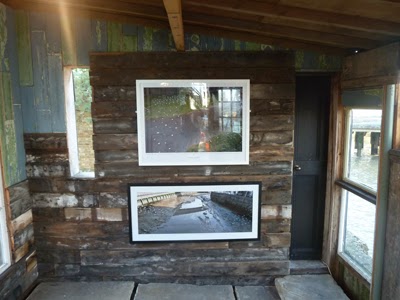I joined forces with two other artists, David Aylward and Laura X Carlé to produce an "Anchor Fest" under the umbrella title "Deptford Is Forever". (www.deptfordisforever.net).
Our aim was to draw attention to the Deptford Anchor which used to sit at the top of Deptford High Street. It was removed earlier this year by the Council as part of regeneration works being done to the high street. Originally the anchor had been installed in 1990 as part of previous regeneration works, but was mounted on a low plinth that over the years had became a sit-down gathering point for the local street drinkers – in full view of the A2 traffic into and out of central London. Undoubtedly, the anchor's removal was intended to displace the street drinkers. A not very well publicised consultation took place in 2012 asking people if the anchor should stay in Deptford or go back to Chatham Historic Dockyard where it originally came from. Overwhelmingly, the response was to keep it in Deptford, since people had become very fond of it and it was the only visible manifestation of Deptford's rich seafaring and shipbuilding history.
When asked when the anchor would return to the high street, Lewisham Council let on that it might end up as part of the new riverside redevelopment at Convoys Wharf at the north of the high street. Lewisham Planning are currently considering an application for the redevelopment of this huge riverside site, but should the site ever receive the permission its owners want, it would be another five years before even the first phase of building is complete.
So we called on citizens to join us in our demand to Lewisham Council to "Give Us Back Our Anchor" and return it to the high street. I designed two single colour tattoos – one as a logo for the project (above), and the other a design to go on white paper counter bags, of which 5000 were printed to be given free to shop keepers and market traders to hand out to customers with their purchases.
This design also demanded that the Royal Dockyard was "saved". This year is the quincentenary of Deptford Dockyard – originally founded by Henry VIII in 1513 – which is now under threat from Convoys Wharf s.a.r.l., a company set up by Chinese conglomerate Hutchison Whampoa, owned by the 8th richest billionaire in the world, Li Ka Shing. They want to build 3,500 luxury flats, with three towers of 48, 38 and 38 storeys and most buildings between 12-18 storeys. All would be built over the historical remains of the dockyard – the slipways, the great basin, the mastponds, Sayes Court Garden (founded by John Evelyn), and other buried structures. Only two structures are to be saved – the double dry dock next to the privately owned (and listed) Master Shipwright's House, and the listed Olympia Shed which covers two other slipways.
A white "ghost anchor" was commissioned from the local florist/grocer High Street Flowers to hang in their window. This wreath was incorporated later into a procession (see below).
A day of "free" tattoos was organised with local tattoo parlour Kids Love Ink in which people could get a little anchor tattoo in return for a donation of up to £15 to a local charity Deptford Reach (who look after people like the street drinkers) and local project Build The Lenox (who want to build a replica 17th ship on the site of the double dry dock).
The Waiting Room coffee shop next door to the tattoo parlour joined in by using our specially stamped takeaway coffee cup cuffs.
And the grand finale was a procession through the high street on market day (Saturday 5th October) with David leading a giant cardboard anchor made by Laura, followed by a band of "rough music" players (brass and drums), and local assorted followers. The procession began at the Dog & Bell pub next to the Convoys Wharf site, and progressed up the high street to the site where the anchor once stood, and stopped along the way at other potential sites – Deptford station and Giffin Square. Eventually the cardboard replica was processed to Lewisham Arthouse, and to Laura's studio where she had originally built it.
We produced T-shirts and cotton shoppers to fund the project. More pix are on the website I designed to document the project.






































